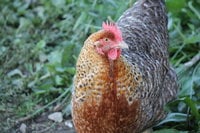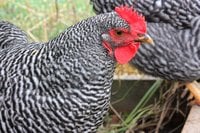If ever I had to restrict myself to a single breed to meat all of my meat, egg and "chicken therapy" needs, this would be the one. Not only are my NNs prolific layers of large to jumbo sized eggs all year round, but they also provide the most delicious meat and are far easier and faster to process than other breeds. They're wonderfully intelligent and feed efficient birds with an abundance of personality. And when it comes to health and hardiness, this breed cannot be beat. Our excessive Arizona summers barely faze them, and while our winters don't get exceptionally cold like other parts of the country do, my NNs have handled freezing temperatures with no signs of discomfort or distress.
The chicks are amazingly hardy and feather out much more quickly than most other fully feathered breeds. Many of my chicks begin roosting on the edge of the brooder by 1 1/2 weeks and are very smart and active. Like most other breeds, however, they still go through an awkward, flighty stage beginning around 3 weeks and lasting until roughly 6 weeks of age. After that they become surprisingly friendly and confident.
Most of my roosters are friendly without being particularly affectionate with the exception of one boy who anxiously waits for me to come outside and sit down so he can jump up on my lap to be pet, but the minute he thinks something may be threatening his girls he's off at a run to protect them. My roosters have also become very adept at distinguishing annoyances like crows from predatory hawks and sound the alarm loud and clear and herd the hens to safety. All of my roosters (I've hatched nearly 3 dozen of them now) have been amazingly attentive to their hens and I've only ever had one rooster that was aggressive. (He was delicious roasted in wine.)
All of my hens have been exceptionally sweet and friendly and it's not uncommon for them to perch on my lap, sometimes several at once, to be pet or just spend time with me. During a bad week I may only get 4 large eggs from one of my hens, but that's a rare occurrence with the majority of my girls giving me 6 huge eggs per week. In fact, my best laying NN only took a break from laying when she molted so heavily as to be completely bald and needed to grow the feathers back. She took 3 weeks off and went right back to giving me jumbo-sized green eggs six days per week, and she's 2 years old.
As you can see from the photo of one of my roosters, you can create amazing color and feather patterns by crossing various breeds with "pure" Naked Neck Turkens. I personally keep three separate lines of NNs. One is my pure line of NNs that I'm working at reaching APA standard with. These birds, so far, tend to run fairly small, but have proven to be exceptionally feed efficient and the little hens lay amazingly large eggs for their size, averaging 5-6 per week each. Although their bodies are smaller than my crosses, their builds have all be very compact and meaty, both hens and roosters alike.
My second line is comprised of my "meat bird" project and I'm working at increasing mass and musculature along with more rapid growth for earlier processing. So far my best hen has weighed in at nearly 8 lbs and my best rooster just over 10. In spite of their larger, meatier bodies, my "meat NN hens" are still giving me just as many large+ eggs per week as my pure line.
And finally my third line, which is a combination of my best egg layers and prettiest feathered birds. This is my "fun" group comprised of NN hybrids to give me both pretty plumage and an abundance of colored eggs, including blue, green, olive green, every shade of tan through brown, and pink. This group also tends to contain some of my broodier hens.
Turkens really are an exceptional breed and I highly recommend that every family farm and homestead have at least a few.





